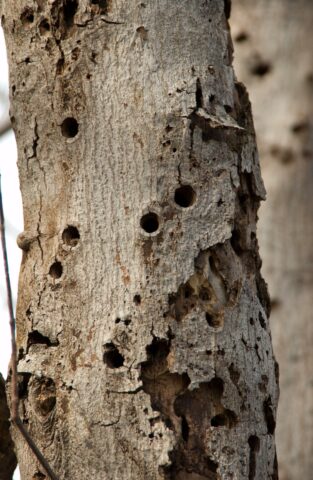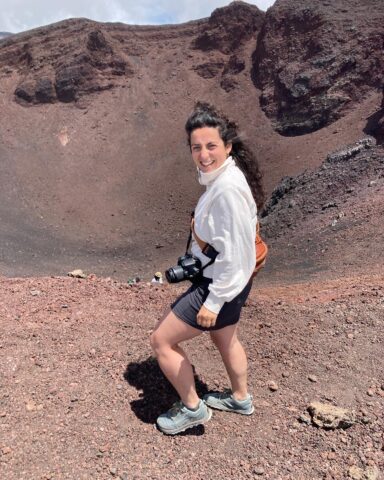2022 Essay Contest Winner
What Climate Models Don’t Show
A scientist’s work on a future forest model can feel personal
by Olivia Box

The trunk of a dying hardwood tree, mottled with the exit holes made by the Asian longhorned beetle (Anoplophora glabripennis). -USDA
Woosh, woosh, thud. The silence of the woods is broken by my clumsiness. In an instant, I’m belly-down on the ground, my arms in a defensive shield in front of my face and my knees taking the brunt of the fall. I am no stranger to abrupt spills when I run. I shuffle my feet, and these New England forests are all roots with just a little bit of flat ground mixed in. I sit up, brushing the duff layer of burnt orange pine needles off my knees. Just a little blood, not bad. I get up and keep going, shaking out my arms and legs. I’ve got miles to go before I resign myself to another day glued to my computer.
Each morning is the same, whether I fall or not. Before the heat becomes too muggy, a new phenomenon for a lifelong New Englander, I slide on my running shoes and leave my phone at home. No directions needed, no need to know my pace.
My first mile is slow as my pores open to the humid air, sweat begins to pool across my eyebrows, neck, and back. Weaving alongside the riverbank, my heavy steps awaken birds and alert the forest that there is an intruder in its midst.
As my runs grew longer, I became more invested in route planning and was enamored with this carefully constructed trail network. Take away the cul-de-sacs, the boxy developments, and the busy roads and beneath the trees lies a tangled yarn ball of trails, enabling me to escape my computer. I needed these trails.
I won’t wax poetic and say I am a member of the forest. But in these brief moments, through the pain of sore feet and a tired body, I am invigorated by the sun streaming through these southern hardwood species. This is the forest type where I feel most at home.
Like many other millennials, I grudgingly moved back in with my parents during the beginning of the novel coronavirus pandemic. For me, home is Groton, Massachusetts, a forested town about 40 miles northwest of Boston. Moving home after years away has been tough, but it has also been an opportunity to explore the area more deeply where I grew up.
I spend the mornings running and the afternoons building a climate-landscape model seeking to predict the long-term management impacts of Asian longhorned beetle (Anoplophora glabripennis) on eastern forests. The beetle is an invasive pest that tore through Worcester in 2008, forcing U.S. Department of Agriculture and other managers to cut every host tree species, primarily maple, to starve out the insect. It largely worked—and took out more than 30,000 trees in the process.
But the future is far less certain for these forests. As climate change intensifies, the conditions will create a dream environment for invasive pests such as the Asian longhorned beetle. From heavy, frequent rains to mild winters, pests are likely to wreak havoc on the landscape.
My model’s landscape is the forests of southeastern New England, primarily comprising maple, oak, and white pine. The soils are sandy and acidic, the growth rates well defined. The seasons are predictable: warm summers, mild falls, harsh winters. But when I add climate change to the mix, everything goes awry.
With my model, I want to see what the composition of these forests will be in 100 years under various climate and pest management scenarios. Since starting my master’s degree in 2018, I have already had to throw out the lowest climate change scenario—emissions have surpassed it. I had to readjust again when the Intergovernmental Panel on Climate Change Sixth Assessment Report came out, as ominous as ever. It’s not news that the apocalypse is here, I think to myself, as my model spins and my computer’s fan whirs to keep up. It’s news that years later, we’re running out time. Climate change isn’t coming—it has been here all along, lurking in the shadows and chipping away at the future we thought we had.
Graduate school dominates most parts of my life. Not just because coding is hard, but because my research hits so close to home. I can’t escape the grief and stress that my model creates. I can’t go on a run without picturing what these forests might look like in 10 years, in 50 years, or in 100 years. The further I get into constructing my model, the more I watch the ecosystem—my backyard—collapse under warming temperatures, invasive pests, and increased rainfall.
The model landscape is where I first became interested in the outdoors. As I build my model, I can see—in glimpses—what the woods will look like. Iconic species such as fir and paper birch will disappear and migrate northward. The woods will get more rain and less snow. Climate change has the inertia of a falling tree: Once it starts, it will inevitably slam into the ground, taking down trees, branches, and habitats with it.
The more work I put into my thesis, the more personal it becomes. Models work in time steps. For mine, I’ve chosen 10-year-increments for 100 years. With each time step, a corresponding personal question arises. In 10 years, I will be 35. Should I have kids? In 20 years, my dad will be 75. He’s asthmatic. Will the air be breathable? And in 100 years, I’ll be long gone. What will the world look like?

Olivia Box on Mount Etna in Sicily. -KELT WILSKA
When I’m working on my computer, I don’t just see pixels. I see Mount Monadnock, the mountain I’ve faithfully climbed in every season. I see the towering pines by the Nashua River, scattering their needles in the lazy currents. I see the resident bobcat disappearing into the hemlocks that line my backyard and hear the barred owl asking Who cooks for you? Who cooks for you? late at night. I see the house I grew up in, surrounded by a hemlock stand that transitions to a classic New England forest: maples and pines in the understory and a thick blanket of leaves on the forest floor.
These forests have been managed for centuries, full of evidence of clear-cuts, new growth, and invasive species—and they will continue to be managed. They are hardly wild.
But still, here is where I first discovered wildness itself. My friends, brothers, and I would build haphazard forts with fallen logs, bark, old tires, and other findings. The accessibility of these forests enabled them to be wild to us. I would call my friends on the landline, and they would bike on over. We would wander through my backyard and into the sliver of woods that separated us from the bordering development. You could see the suburban pastel houses through the trees in the distance, but that didn’t matter.
With each scenario I create, from business-as-usual climate emissions to extreme emissions, I see the forest types change and shift and my backyard change. With severe pest management, we have a chance to preserve certain species from destruction, but at long time scales that are hard to conceptualize and feel counterintuitive. Cut down the trees, save the forest. These scenarios require patience. But when I close my eyes, all I see are the trails that I love disappearing.
George Box (no relation), a British statistician, once said, “All models are wrong, but some are useful.” I used to think he meant models sputter out our results but need humans to sort through them. It gives us a role in the chaos to intervene and decide what is accurate or how to use these results to our advantage.
I think maybe he meant something else, too. Models can be illuminating and reassure our experimental methodology, but they miss the intricacies of the human experience. They miss the way the forest feels after rain and the damp air and the waterlogged soil, the sweet, pattering sound of treedrip. They miss the joys and pains of trail running, weaving over roots, swatting away bugs, catching the light through the understory.
This is what I want to preserve, what I wish my model could show. These forests—though managed beyond their natural state—are wild, if we take wild to mean unpredictable and worthy of exploration.
My model will churn out facts about how many trees will inhabit these forests and which species will survive. As I see the ecosystem crumble, older people tell me to have hope, but I can’t put hope into a model.
“Let your hands be loose, like you’re holding a potato chip,” my high school cross-country coach would call to us as we ran loops around the manicured soccer field. I’ve always struggled with tensing my shoulders when I run, my fists tight. But when I remembered to open my hands, I felt lighter and faster even if I wasn’t.
I’m trying to run less tense these days, to keep my hands open and loose. Hope is something we must take into our own hands and cradle with care. Models, though helpful for discovering problems or suggesting pathways, don’t include all the elements that affect the environment: activism, conservation, and good old-fashioned hope.
Recently, the local volunteer-driven land trust preserved hundreds of acres around my childhood home as a conservation easement. These acres can never be developed and will remain a wildlife corridor that stretches from the banks of the Nashua River all the way to New Hampshire. When I build a model, I know that there’s more happening beneath the pixels.
Is it perfect? Of course not. But conservation—like models—is not meant to be perfect. Instead, it tells us stories of what the world could look like. Having hope can give us the agency to choose which story we want to tell the next generation. Will it be a story of species loss, or growth? I hope it will be a story of stewardship in our own backyards, of curbing emissions, of long trail runs, of hope.
In a well-timed letter from a friend, she casually wrote, “Things are good here. Today was 40 degrees so I ran outside and had one of those spring-weather runs where I couldn’t help but smile and hold my arms out and feel grateful for my lungs. I mean 40 in January days after a historic blizzard isn’t great, but at least there will be moments of joy in the apocalypse.”
This morning is no different from the rest. I slip on my muddy sneakers and set out on the dirt road where I start each morning. At the trail intersection, I veer right this time. It’s September and the riverbank grasses are lush and long.
Sweat begins to pool in those familiar places, my face, neck, and back. My pulse quickens and my breathing starts to even out. I open up my stride, relax my shoulders, and let the river grass tickle my hips. The wetness on my legs from the morning dew and the stickiness on my face from the spiderwebs spun overnight indicate that I’m the first one here this morning.
But I know that’s not true—many have been awake before me. There are chickadees flirting with one another in the trees, insects bustling in a fury, squirrels and chipmunks meticulously checking their caches. Nothing special, but thankfully familiar. I am just passing through, carrying my joy through the apocalypse.
Olivia Box explores the areas where climate change, ecology, and storytelling meet. An ecologist and writer, she has a degree in forest ecology from the University of Vermont and an undergraduate degree from Hamilton College. Last year, she was a Fulbright student scholar based in Viterbo, Italy, studying UNESCO World Heritage old-growth forests, science communication, and the Italian language.
